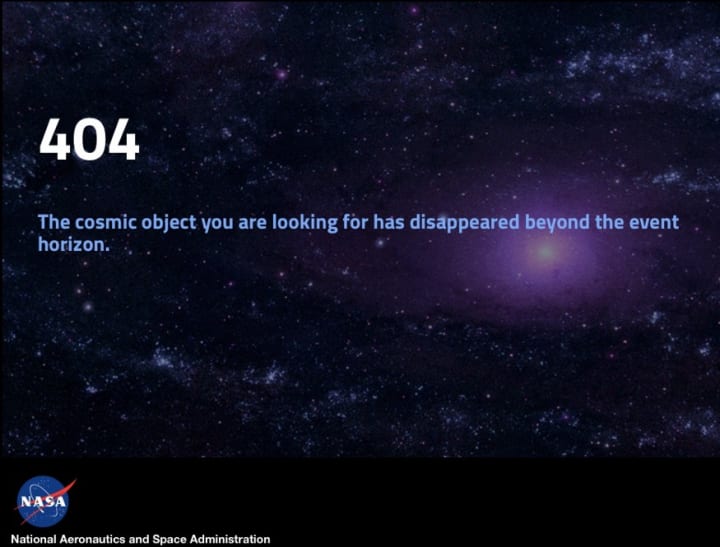Digital Amnesia
The content you’re looking for has slipped into digital nothingness

This article was written by John Mulnix and originally published in The Particle on 6/23/2020.
What is digital amnesia? It’s also known as digital obsolescence, but basically, it happens when a file, website, or piece of computer hardware can no longer be read or function, thereby depriving us of the ability to read the contents stored in that medium.
What I’ve found in some cases while researching episodes of The Space Shot, is that a lot of space mission websites have just been left as is; HTML code and web design that dates to the late 1990s and early 2000s.
Links that used to be functional are broken, even on newer NASA websites from the past ten or twenty years. Heck, I’ve run into this with blog posts I made just a few years ago and show notes from my podcast. Links and websites that I linked to or shared are no longer accessible.
In a funny, albeit eerily apropos message on NASA’s website, the message that displays for pages that are no longer in existence states: “The cosmic object you are looking for has disappeared beyond the event horizon.”

It’s an accurate and amusing description of what happened to a particular webpage, but not exactly the message that a researcher or interested member of the public wants to see.
So why am I talking about all of this? Well, digital amnesia can pose a problem to historians and to the public. The ephemeral nature of digital content means it can be modified or deleted at a whim. Modifying digital content without acknowledging edits is another problem that could be more pernicious in the long run, but I’m leaving that topic alone for now so we can talk about the latest digital craze, NFTs.
NFTs or non-fungible tokens are blockchain-based items that:
“we can use to represent ownership of unique items. They let us tokenise things like art, collectibles, even real estate. They can only have one official owner at a time and they’re secured by the Ethereum blockchain — no one can modify the record of ownership or copy/paste a new NFT into existence.”- Ethereum NFT website
Digital ownership of items that can be viewed for free online in many cases. Memes, photographs, and stills from videos are many of the items that are now NFTs. Why someone would pay tens of thousands of dollars for digital “art” is beyond me and I’m sure you’re asking yourself the same question. Not to mention, NFTs could also face the same fate as deleted NASA webpages; slipping beyond the event horizon and effectively erasing the “value” of the digital token you purchased. Digital amnesia for a supposedly unique piece of art sounds like a bad investment to me.
Now, this is the part where we do a hard turn into political theory. Hang tight, the direction change has a point.
In his seminal work “Democracy in America” Alexis de Tocqueville wrote about the characteristics of the modern society he was viewing firsthand.
“The society of the modern world which I have sought to delineate, and which I seek to judge, has but just come into existence. Time has not yet shaped it into perfect form: the great revolution by which it has been created is not yet over: and amidst the occurrences of our time, it is almost impossible to discern what will pass away with the revolution itself, and what will survive its close. The world which is rising into existence is still half encumbered by the remains of the world which is waning into decay; and amidst the vast perplexity of human affairs, none can say how much of ancient institutions and former manners will remain, or how much will completely disappear. Although the revolution which is taking place in the social condition, the laws, the opinions, and the feelings of men, is still very far from being terminated, yet its results already admit of no comparison with anything that the world has ever before witnessed. I go back from age to age up to the remotest antiquity; but I find no parallel to what is occurring before my eyes: as the past has ceased to throw its light upon the future, the mind of man wanders in obscurity.”
There’s a lot to unpack there, but I want to focus on that final line, “as the past has ceased to throw its light upon the future, the mind of man wanders in obscurity.”
Tocqueville couldn’t have foreseen bit rot or digital amnesia, but this last line perfectly encapsulates the dangers of digital, modifiable, and fallible online storage mediums.
Websites and web content that can be modified, removed or tampered with pose a serious problem to modern society. Whether a change is deliberate or inadvertent, the results of digital amnesia can be the same. The loss of historical records, news, and digital content can very well put us on the road to wandering in digital obscurity.
At times I fear that digital storage mediums, websites, and items like NFTs don’t offer enough permanence to leave us with information we could use 5, 10, or 20 years from now. How can we foster the cultivation of a digital landscape that captures the laws, opinions, and feelings of those of us living in this digital century?
I’d love to hear your thoughts, so send me a message or leave a comment if you’d like.
About the Creator
The Particle Publication
Particle — a minute portion of matter
While we never truly see them with our eyes, particles create the world as we know it, matter.
In that same theme, we bring to you The Particle. Each article written is a part of a larger picture.






Comments
There are no comments for this story
Be the first to respond and start the conversation.